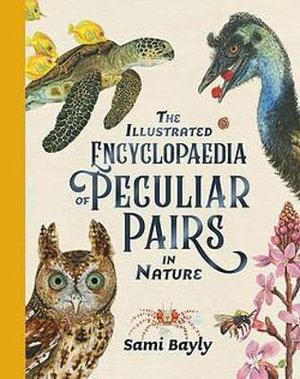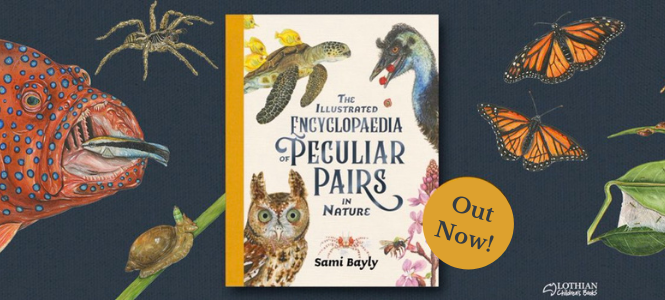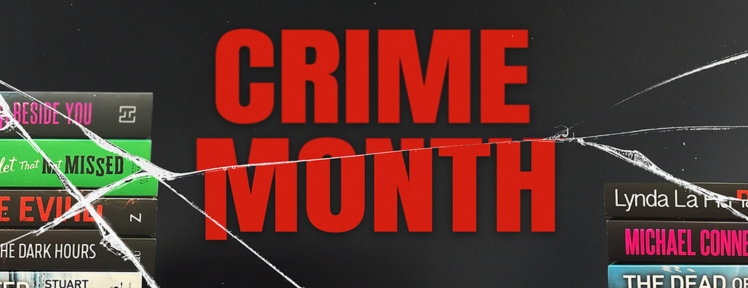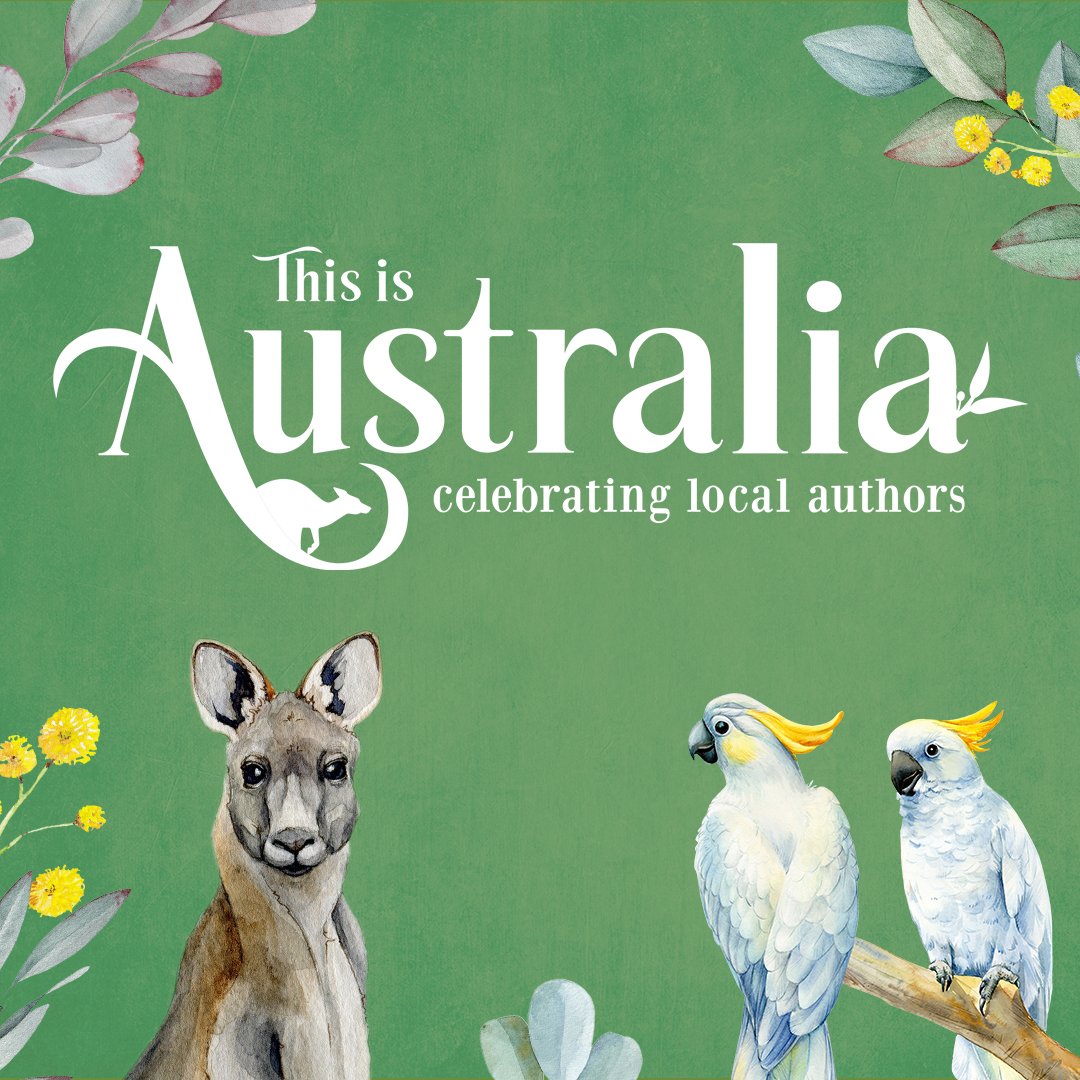Sami Bayly is a 25 year old natural history illustrator based in Armidale, NSW, who loves all things weird and wonderful. She finds the beauty and importance of all animals regardless of their appearance, and hopes to share her appreciation with others. Both of her previous books (The Illustrated Encyclopaedia of Ugly Animals and The Illustrated Encyclopaedia of Dangerous Animals) have been the recipient of multiple awards, including being the winner of the Children’s Indie Book of the Year Award and the Australian Book Design Award. As well as receiving the Honour Award for the CBCA Eve Pownall Award category twice.
Today, Sami Bayly is on the blog to answer a few of our questions about her brand new book, The Illustrated Encyclopaedia of Peculiar Pairs in Nature! Read on …
Please tell us about your book, The Illustrated Encyclopaedia of Peculiar Pairs in Nature!
SB: Inside this encyclopaedia, we will uncover some of the most bizarre, wonderful and downright disturbing peculiar pairs that nature has to offer. Over half of these pairs call Australia home and have built a special connection with the land over millions of years and Indigenous peoples for over 65,000 years.
While some of you might be familiar with the term mutualism, have you heard of the not so straightforward partnerships like commensalism and parasitism? What about perplexing labels like Müllerian mimicry or inquilinism commensalism? Well in this book you are going to find out about all of these definitions and more, uncovering 60 pairs along the way that are the most peculiar and downright disturbing partnerships nature has to offer. Each one of these partnerships has been carefully painted with watercolours over many months in order to portray the curious behaviours that plants and animals around the world have adapted in order to benefit their lives. By learning about these pairs you will gain an awareness of the extraordinary relationships throughout the globe and we as a society will have a better chance of protecting and conserving them for years and years to come.
You’ve tackled ugly animals and dangerous animals in your previous picture books. What interests you about animal pairs?
SB: I was brainstorming with the team at Hachette and the Biodiversity Conservation Trust (a not-for-profit environmental organisation who offered me a grant and assistance with the scientific aspects) about what this third book might look like, we found ourselves continuously getting stuck on the amazing symbiotic relationships in nature, like the Moreton Bay Fig and the Fig Wasp. However, we knew that by only allowing symbiotic partnerships in the book, it would rule out many other fascinating relationships which were equally as striking, like the Green-banded Broodsac and the Amber Snail. A parasitic partnership in which a small parasitic worm enters a snail and takes up accommodation inside the eyestalk, controlling the snails actions and eventually leading it to a hungry bird. A strategy that works all too well for the parasite, as it needs to be inside the rectum of the bird in order to complete its life cycle.
Understanding the unexpected interactions between species in nature fascinated me and allowed me see the world in a whole different light. Why do we learn about the beautiful Glossy Black Cockatoo but not the important Drooping She-oak that houses and feeds it, when both are just as vital to the environment as each other? I think this concept alone made me realise that this was a subject just waiting to have an illustrated encyclopaedia created on it.
What’s the most fascinating thing you learned during the creation of this book?
SB: With so many interesting and unusual animals in this book, it is really tricky to narrow it down to just one fascinating fact that I learnt when making the book. But if I had to choose, it would be that there is a fish that spends its day living inside the bottom of a sea cucumber. The Pinhead Pearlfish is a long and slender species of fish that swims inside the rear end of a slow moving log-shaped creature called a Leopard Sea Cucumber, drawn in by the smells. These sneaky fish squeeze in and find safety amongst the guts, hiding inside during the day only to leave at night in search of food. Not only is this one of the most bizarre and downright disturbing animal facts I have ever discovered, it is also a brilliant and hilarious fun fact to share if you ever need to break the ice.
‘Understanding the unexpected interactions between species in nature fascinated me and allowed me see the world in a whole different light. Why do we learn about the beautiful Glossy Black Cockatoo but not the important Drooping She-oak that houses and feeds it, when both are just as vital to the environment as each other?’
Can you tell us a little about your process? How do you decide on which animals go into the book? Where do you start with illustrating them?
SB: The entire process always starts with a word doc numbered 1-60 down the page, as it is essentially my way of keeping track as to what animals I think would be great to include in the book and their scientific names.
In order to find the different species that you see included in the books, I will usually begin my research by a good old fashion Google search using a few key words, like “animal relationships”, or “unexpected friendships in nature”, as it is the most efficient way to see what creatures the majority of people are aware of or what are the ones covered most in media. This doesn’t rule them out per say, but it does help me steer the book in a unique direction and allow for the more unexpected additions. I then talk to experts in the field, scientists and organisations such as the BCT (Biodiversity Conservation Trust) to explore the in more details the overlooked peculiar pairs.
I also love to brainstorm with others, like my family, friends and social media, to see what comes to mind when you ask them about different species connecting in nature. These different approaches usually result in me frequently swapping species in and out to make sure I am featuring the best animals and most peculiar pairs nature has to offer.
After I have made a rough list of the 60 pairs I am wanting to include, I will begin more in depth research, making sure the animals I have chosen are suitable. It is crucial for me to understand their ecology so that I am able to sketch them in a way that reflects their nature and relationship. However, the text at this point is still in a rough draft and is not finalised or extended until the majority of the artworks are completed.
You answered our Ten Terrifying Questions back in 2019, and you’ve come such a long way since then. Did you ever think that readers would love your books as much as you loved making them? (And did you ever get to visit all of the ugly animals?!)
SB: It doesn’t feel like 2 years ago I was answering the Ten Terrifying Questions … time really has flown. Although, when I think back to that time, it was terrifying in more ways than just the questions, as it was actually one of my very first interviews as an illustrator and author!
In the beginning of my career when I was just a university student looking to start my honours, I thought that this opportunity seemed way too good to be true and that everything would fizzle out before I had the chance to show what I could do. I think that came for a lack of confidence in my own talents and the belief that there was no way someone would buy a book written or illustrated by me. I certainly wasn’t prepared for the gravity that the books would have on kids around Australia and thought that maybe I would be lucky enough to have a few books make it into a bookshop that only my family and friends would be buying. So the fact that I am sitting here writing about my third book and having the fantastic opportunity to visit schools and teach them all about the endless interesting animal facts is truly mind-boggling.
 Unfortunately, I have not yet been able to visit all of the ugly animals. The goal of visiting all 60 uglies might have been a little dramatic … and now adding on the 60 dangerous animals plus the 60 peculiar pairs, it seems that I have a lot of traveling ahead of me! However, this new book has over half of its peculiar pairs found within Australia, so that means I have a much higher chance at visiting them all, especially while international travel is ruled out. Here’s hoping I reach that goal over the next few years!
Unfortunately, I have not yet been able to visit all of the ugly animals. The goal of visiting all 60 uglies might have been a little dramatic … and now adding on the 60 dangerous animals plus the 60 peculiar pairs, it seems that I have a lot of traveling ahead of me! However, this new book has over half of its peculiar pairs found within Australia, so that means I have a much higher chance at visiting them all, especially while international travel is ruled out. Here’s hoping I reach that goal over the next few years!
What do you love about writing and illustrating books for younger readers?
SB: What’s not to love! Not only am I able to share the stories and science behind so many mind-blowing species, but I also have the pleasure of encouraging children to pick up a book and start reading. I know that young people can struggle to want to read non-fiction books, especially the boys, so the fact that many of them are drawn to the weird, dangerous and unsettling aspects of nature means that many have actually really enjoyed my books. It has even helped some of them dive into the pages of other non-fiction books.
All I hope is that people (kids especially) are able to walk away from my books feeling like they have learnt something about the world that they didn’t know before, with a fresh and positive outlook on nature and the incredible species within.
Who do you most admire in the illustrating world?
SB: After completing a Bachelor of Natural History Illustration, I was introduced to so many talented and admirable scientific illustrators. Not only from the past but also from my very own cohort, as I met so many inspirational illustrators who were fellow students and lectures.
Someone in particular who stuck out to me while exploring the natural history illustration world was William T. Cooper, an exceptional artist who grew up in the same area as I was studying. He painted realistic flora and fauna (with birds being a favourite subject of his) and published many beautiful books showcasing all of the detailed pieces. Seeing someone so close to home who had lived the life I had only dreamt of helped me believe in myself and pursue my goals of being a scientific illustrator.
He even was even described by Sir David Attenborough as “Australia’s greatest living scientific painter of birds, he is possibly the best in the world.”
What is the last book you read and loved?
SB: I am actually reading a book right now called Swordfish: A Biography of the Ocean Gladiator, written by Richard Ellis. This fantastic book focuses on one particular species (the swordfish), exploring the early sightings of the swordfish in history, their biology, dangerous abilities, conservation status, the stereotypes that surround them and more. And if you have ever read my books, you will know that this format and areas of content are right up my alley! So getting to read a book that covers all of those topics at such depths is an absolute delight for me.
What do you hope readers will discover in The Illustrated Encyclopaedia of Peculiar Pairs in Nature?
SB: I hope that when the readers open up this new Encyclopaedia, they are immersed with the captivating stories behind each and every peculiar pair. This might seem dramatic but I think when you begin reading it won’t sounds like a far-fetched goal at all!
Whether you have an interest in beautiful birds like the seedpod munching Glossy Black Cockatoo, dangerous animals like the whopping 5-6 metre long Nile Crocodile or odd creatures like the Carrier Crab who piggybacks a Fire Urchin around the ocean floor, this book will stop anyone in their tracks and teach even the most animal savvy child so much about nature.
I hope that the readers are able to walk away from the book with a deeper understanding of nature and the strange ways in which it works. Maybe they will start to look at animals and plants differently and uncover some extraordinary partnerships in their very own backyards.
And finally, what’s up next for you?
SB: The answer to that question is something that I am still trying to work out! I know that there are more books in store for me at Hachette and we are in the exciting phase of brainstorming as to what they might look like at this very moment.
I do know however, that The Illustrated Encyclopaedia of Peculiar Pairs in Nature is the final of the illustrated encyclopaedia series. So my future books will be in a new format that unearths the natural world in a fresh way and I cannot wait to see what that might look like. I can safely say though, that the unconventional flora and fauna of the world will always be my motivation.
Thanks Sami!
—The Illustrated Encyclopaedia of Peculiar Pairs in Nature by Sami Bayly (Hachette Australia) is out now.

The Illustrated Encyclopaedia of Peculiar Pairs in Nature
Discover 60 of the most peculiar pairs in nature and learn how plant and animal species rely on each other for their survival.
Whether it be a rare tick living in the fur of a pygmy possum, a stick insect feasting and hiding out amongst the Melaleuca or a handfish laying its eggs on a sea squirt, incredible natural relationships deserve to be explored and celebrated. Investigating all types of relationships, from symbiotic to parasitic, this is an eye-opening guide to the natural world...








 What do we know about the Boy Swallows Universe Netflix show?
What do we know about the Boy Swallows Universe Netflix show?  Booktopia’s top thrilling fiction picks for Crime Month
Booktopia’s top thrilling fiction picks for Crime Month  Booktopia’s Top First Nations Book Recommendations for 2023
Booktopia’s Top First Nations Book Recommendations for 2023
Comments
No comments